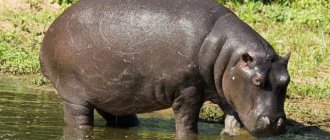bobot 10/09/201807/23/2021 Category AnimalsTags hippopotamuses, hippopotamuses, facts Comment.
What is the difference between a hippopotamus and a hippopotamus?
Every person knows most of the animals that are known to science, but the subspecies of the same animal species are not known to everyone. One of the animals that few people have in-depth knowledge about are the hippopotamus and hippopotamus. These mammals are so similar that it is impossible to tell them apart, but that's why they have different names. It's worth understanding.
Common hippopotamus and hippopotamus - differences
You should not lead the reader by the nose for a long time, tormenting him with omissions. If the question concerns the animal called the common hippopotamus, then it is worth noting that it belongs to the Hippopotamidae family, which also has a Latin name - Hippopotamidae. Trying to read this word, everyone will understand why this animal can have two names.
In other words, the names “hippopotamus” and “hippopotamus” are equally suitable for this mammal. There is no difference between the animals they call. It’s just that one word is the species name of a mammal, and the second has a broader meaning. It indicates the family the species belongs to. In this case, “hippopotamus” and “hippopotamus” are one and the same.
Why do whales wash ashore?
General theories include: noise pollution of the ocean (including sonar), which injures the organs of hearing and echolocation, which has been proven in some cases; panic due to attack by predators (for example, killer whales); hunting for squid and fish too close to the coast; weakness due to old age, poor...
Interesting materials:
Is it possible to put Schefflera in the bedroom? Can you remove nail polish with alcohol? Is it possible to sterilize instruments in the oven? Is it possible to sterilize files? Is it possible to have a Decembrist haircut? Is it possible to cut Konik? Is it possible to dry gel polish without a lamp? Is it possible to dry gel polish with a regular ice lamp? Is it possible to dry walnuts in the sun? Can you dry walnuts in the microwave?
Etymology of these words
So, we came to the conclusion that the definitions “common hippopotamus” and “hippopotamus” are synonyms, but derived from the roots of words from different languages.
The first name came to us from Hebrew. It means “beast” in translation. But the second word - “hippopotamus” - is Latin. Moreover, it came to Latin from the Greek language. It is from “hippopotamus” that the international scientific name of these mammals comes from. It literally means “river horse.”
Thus, there are differences between the words “hippopotamus” and “hippopotamus”. Just to find them you need to look into the etymological dictionary.
Commercial value
In ancient times, hunting sperm whales brought fabulous profits to industry. Already in the 11th century, the Basques hunted these mammals in the Bay of Biscay, and in North America they began to practice this in the 17th century. Sperm whales were mainly exterminated for the sake of obtaining fat. Until the 19th century, sperm whale fat was considered the only product that satisfied all medical needs. From the fat of these animals, fuel for lighting devices was produced, a lubricant was made from it, a solution for softening the skin when making various products from it, as well as in other important processes. Soap and margarine were mainly made from this fat. The chemical industry used sperm whale oil in its technological processes.
Interesting moment! Cetaceans are mammals whose ancestors once lived on land. Their fins resemble webbed hands, although for thousands of years, living in the water column, these animals have become accustomed to this habitat.
As a rule, the fattest were the individuals that were caught in the spring and summer in the vast Arctic. It was possible to obtain up to 8 thousand kilograms of fat from one adult sperm whale. In 1946, a special international committee was created to oversee the protection of sperm whales. To this day, this organization directs its efforts to support and control the numbers of these mammals. In fact, the committee’s efforts were not enough, and the total number of sperm whales is inexorably approaching zero.
Nowadays, hunting sperm whales on a commercial scale does not make much sense, as in the old days, and those extreme sports enthusiasts who dare to kill a sperm whale can pay dearly, even ending up behind bars. In addition to fat, sperm whales have quite tasty meat, and fertilizers are made from their bones. Their bodies serve as a source of ambergris, which is highly valued, and this substance is produced in the intestines of the sperm whale. This substance is used in the manufacture of perfumes. In addition, the cost of sperm whale teeth is not inferior to the cost of ivory.
Pygmy and common hippopotamuses - different species and different families
Previously, these two species were classified as one genus. In scientific circles it was called Hippopotamus, that is, “hippopotamus.” Apparently, then these words appeared in dictionaries of synonyms in the same row.
But more recently it was discovered that there are big differences between these species. And therefore, the pygmy hippopotamus was allocated to a separate genus, which is called Hexaprotodon, after the name of extinct hippopotamuses.
So the answer to the question of how a hippopotamus differs from a hippopotamus can be a pun. It is in it that the main semantic features of these two words are revealed. “Every hippopotamus is a hippopotamus, but not every hippopotamus is a hippopotamus.”
What is the speed of a hippopotamus in water?
Hippos are excellent swimmers and divers, capable of staying under water for two or more minutes and at the same time reaching speeds along the bottom of up to 13 km/h.
Interesting materials:
How to find out your current account number in Sberbank? How can I find out my current account number? How to find out your Kcell phone number? How to find out Play phone number? How to find an eBay buyer's phone number? How to find out a phone number from a spinning top? How to find out the track number of a letter? How to find out the number of three? How to find out the driver's number in Yandex Taxi? How do I find out my ozone order number?
Who is the ancestor of hippos?
It just so happened that hippos and pigs began to be considered the closest relatives. And this opinion prevailed for many years. But it turns out that hippos are closer not to pigs and wild boars, but... to whales! Although these are still only assumptions of scientists. And not everyone from the world of science accepts this statement as truly true.
According to the modern version, about fifty million years ago on Earth there existed a kind of animal, similar in size to the current raccoon, which was given the name Indohyus. Subsequently, thanks to evolution, his descendants were divided into two branches. From one came whales, and from the other hippopotamuses.
Today there are only two species of these mammals left on the planet. These are common and pygmy hippos. Both of them live only on one continent - Africa.
Appearance
His body resembles a huge barrel, his legs are thick and so short that his stomach almost drags along the ground when he walks. The length can be up to 4 m, and the weight is simply fantastic - up to 5 tons! After elephants, the hippopotamus is in second place in size, as is the rhinoceros.
The tail is short, but quite mobile, with the help of it it sprays droppings and urine - it marks the territory.
The paws have 4 webbed toes. When walking through mud, the toes spread out, and the taut membrane helps prevent slipping and falling through.
The wide mouth hides huge incisors, the length of which can reach 40-50 cm.
The ears are small, but with them he constantly tries to ward off insects. The head resembles a roughly hewn rectangle, and the muzzle is covered with special sensitive hairs. In many photos, the hippopotamus is captured with its mouth wide open - and indeed it can open it up to 150 degrees.
It contains 36 frightening-looking fang teeth. He uses them as protection or digs the ground.
The eyes are very small, with large folds of the eyelids around them.
Hippopotamus underwater
The skin is thick, dense, brown-gray in color, with a small amount of hair.
Differences between pygmy hippos and ordinary hippos
In appearance, these mammals are very similar. Pygmy hippos appear to be smaller copies of ordinary hippos. But nevertheless, these are different animals. And answering the question of how a hippopotamus differs from a hippopotamus, we should probably compare them. After all, differences between these two species living today are observed not only in size, but also in the structure of the skeleton, skull, and number of teeth.
Pygmy hippos have longer legs and necks than ordinary hippos. Their skull is also smaller. If the spine of a hippopotamus usually has a horizontal position, then in pygmy hippopotamuses the back is slightly tilted forward.
The differences between these species can even be “read on the face.” In dwarf hippos, the nostrils and eyes protrude less noticeably than in ordinary hippos. And their toes are spread further apart. Moreover, the membranes in the dwarf species are expressed to a much lesser extent.
An interesting detail is the color of the sweat of pygmy hippos. They have it pink! But don’t think that it contains blood particles - this is not true at all.
It is also worth noting the difference in behavior between pygmy and ordinary hippopotamuses. Hippos are quite aggressive creatures. They are sensitive to protecting their territory. Pygmy hippopotamuses usually don’t care if a stranger accidentally wanders into their habitat. They never start internecine wars over territory; they practically never fight over females.
It is this feature that allows them to keep small hippos as pets. Although in adulthood they can reach a weight of two hundred and eighty kilograms. But this is not four and a half tons, which is what adult hippopotamuses become!
Dwarf hippos also differ from ordinary hippos in that they prefer to lead a solitary lifestyle. Hippopotamuses usually live in compact schools.
Definition
They are fat, but terribly cute, clumsy, but capable of instantly attacking the boat of a lone tourist. Animals seem to be very lazy and cute, but be careful not to make them angry! Let's get to know them better.
Hippopotamus (or hippopotamus) is one of the largest land animals. They can weigh up to four tons and in this category they can compete with rhinoceroses in the battle for second place behind elephants. A distinctive feature of these large and clumsy creatures is their semi-aquatic lifestyle.
Hippopotamuses (hippos) can spend a significant part of their time in the water, and only come to land at night and for only a few hours to feed. It most often lives near fresh water, but sometimes wanders into the sea.
Previously, it was believed that the closest relatives of the hippopotamus were pigs, but now there is an opinion that there are other relatives in the pedigree - whales. This animal lives in Africa, although in ancient times its habitat was much wider, perhaps it was even found in the Middle East.
Despite its wide popularity, the hippopotamus has been little studied. Its habits, lifestyle and habits, genetic connections with other animals and physiological features are currently being actively studied. It is reliably known that this is a large animal, with a barrel-shaped body on short and thick legs. There is a blunt, huge head, nostrils slightly raised to breathe in water, a short neck, small eyes, large teeth, which can be very dangerous.
The color of the skin is gray-brown with a pink tint. It can also be noted that it is very durable and thick, can reach a thickness of 4 centimeters. There is practically no fur, but there are numerous hard hairs on the face. There is also coarse and sparse hair, similar to pig bristles.
One of the reasons for the aquatic lifestyle is that on land the hippopotamus loses moisture from the body faster than other animals, so it simply needs such a habitat.
taxonomy
The system and taxonomy used are largely consistent with the review by Boisserie (2005). [ 5 ]
- The genus Hippopotamus
are true hippopotamuses.
Hippopotamus amphibius
is a common hippopotamus in Africa. - Hippopotamus antiquus
† - Europe and the British Isles; Pleistocene - Hippopotamus creutzburgi
† - Crete; Pleistocene - Lesser hippopotamus
† - Cyprus; Pleistocene to Holocene - Hippopotamus melitensis
† - Malta; Pleistocene - Hippopotamus pentlandi
† - Sicily; Pleistocene - Hippopotamus lemerlei
† - Madagascar; Holocene - Hippopotamus laloumena
† - Madagascar; Holocene - Hippopotamus gorgops
† - Africa and continental Europe; Late Miocene – Middle Pleistocene
:
- Hippopotamus aethiopicus
† - Kenya and Ethiopia; Pliocene-Pleistocene
† — anteriormente género
Trilobophorus
† —
† - Central Africa; Pliocene
† - Morocco and Algeria; Pleistocene
- Asian hippos.
- Hexaprotodon bruneti
†—Ethiopia; Pliocene
† - Ethiopia; Pliocene
† - Spain;
Late Miocene (syn. Hexaprotodon primaevus
)
† – Argelia
† - Uganda and Congo Basin; Pliocene
† - Burma; Pliocene-Pleistocene
† - Kenya and Eritrea; Pleistocene
† - Madagascar; Holocene
† - India;
(possibly the same as Hex. palaeindicus
)
† - India;
† - Italy; Pliocene
† - Kenya and Chad; Pliocene
† —
† - India
sp. † (not described) - Myanmar
- The genus Archeopotamus
was formerly part of
Hexaprotodon. Archaeopotamus harvardi
† - Arabia and Central Africa; Miocene-Pliocene - Archaeopotamus lothagamensis
†—Kenya; Miocene
- dwarf hippopotamuses.
- Choeropsis liberiensis
- pygmy hippopotamus
- was previously a member
Hexaprotodon.
- Saotherium mingoz
Chad; Pliocene
Other names
In many countries, at the moment, in order to name the animal mentioned above, various forms of the Latin “” are used. But in some countries they do not use this word, but simply call it its literal translation (river horse) in their native language. This is what the Germans and Swedes do, for example.
Sometimes the name of the animal is changed. So, in some languages, the hippopotamus was given the name of a certain river, receiving a new, proper name “Nile Horse”.
Curiosities
When the hypothalamus feeds its young, the color of the milk is pink. It is the only mammal capable of coloring breast milk.
Similarly, the color of the sweat secretions of these animals also has a pinkish tint. After analyzing the compounds that form the mucus, two pigments were isolated that give the liquid its bloody appearance. One is responsible for the color red and the other for orange, and they have been christened by Kyoto Pharmaceutical University (Japan) as hyposudoric acid and norgiposudoric acid, respectively. Nature magazine
was responsible for the publication of this discovery. [6]
Bibliography
- Boissery, Jean-Reno (2005). "Phylogeny and taxonomy of Hippopotamidae (Mammalia: Artiodactyla): a review based on morphological and cladistic analysis". Zoological Journal of the Linnean Society
(in English)
143
(1): 1–26. doi: 10.1111/j.1096-3642.2004.00138.x. - Petronio, C. (1995). "A note on the taxonomy of Pleistocene hippopotamuses". Capricorn - Journal of Mountain Ecology
(3): 53-55. Archived from the original on September 12, 2008.
Reviews
Inga Stanitskaya, 30 years old, Ufa.
I probably thought until the 5th grade that hippopotamuses differ from hippopotamuses in that some live in America and others in Africa. I learned the “truth” from my father during my next trip to the circus. Then the hippos were performing, and there I asked him why in Africa hippos are called hippos, but in America it’s the other way around. At first his eyes became round, and then he laughed, and I somehow felt uneasy, even offended. The next day he told me everything in detail.
Lyubov Zhirova, 45 years old, Surgut.
There is a description of a hippopotamus in the Bible; you can find it in the Old Testament, Job 40:10-18. I’ll give a few quotes in my own words, otherwise I don’t remember much. I know for sure that his habits were described, and they were like those of an animal, so he ate grass. And the body, according to the same description, is very similar to a hippopotamus. So, a hippopotamus has legs like copper pipes, its strength is in its loins and belly, its tail is like a cedar. And there is also a resemblance to a real animal in its character, since the biblical beast is calm in nature.
Evgeny Kurochkin, 50 years old, St. Petersburg.
No matter what anyone said, I would never have found any similarity between horses and hippos. Moreover, compare with whales. No, well, I still understand that these and those mammals At this rate, I can say that hippos are similar to sea lions, or rather cows. By the way, I would say that these animals look much more like an ordinary cow than horses. At least in terms of volume for sure.











